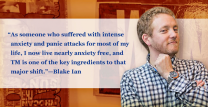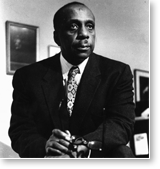Howard Thurman
1899–1981 • UNITED STATES
Minister, author, philosopher, theologian, educator, civil rights leader, and one of the most important figures in African American history, Howard Thurman was born in Florida and grew up in a world of segregation.
He went to Morehouse College, where he was a classmate and friend of Martin Luther King, Sr., and graduated first in his class. He next went to divinity school and at 26 was ordained a Baptist minister. After pastoring a church in Ohio, he became the dean of chapel and a faculty member in the School of Divinity at Howard University, in Washington DC.
Traveling to India, he was able to meet two people he revered, Mahatma Gandhi and Rabindranath Tagore. He helped establish the Church for the Fellowship of All Peoples in San Francisco, the first racially and culturally integrated church in the US.
He went to Boston University, where he taught in the School of Theology and served as dean of chapel, the first black to hold a deanship at a predominantly white university. He mentored Dr. Martin Luther King, Jr., who was doing his doctoral studies there, introducing King to Gandhi’s philosophy of nonviolent resistance.
Thurman wrote 20 books, beautifully composed, deeply felt reflections on life and living.
One theme that runs through his books is the experience of deep inner peace and silence. Here is an example:
There is no clear distinction between mind and spirit; but there is a quality of mind that is more than thought and the process of thought: this quality involves feelings and the wholeness in which the life of man has its
being. . . . What is being considered is what a man means totally when he says, “I am.” This “self” shares profoundly in the rhythm that holds and releases but never lets go. There is the rest of detachment and withdrawal when the spirit moves into the depths of the region of the Great Silence, where world weariness is washed away and blurred vision is once again prepared for the focus of the long view where seeking and finding are so united that failure and frustration, real though they are, are no longer felt to be ultimately real. Here the Presence of God is sensed as an all-pervasive aliveness which materializes into concreteness of communion: the reality of prayer. Here God speaks without words and the self listens without ears. Here at last, glimpses of the meaning of all things and the meaning of one’s own life are seen with all their strivings. To accept this is one meaning of the good line, “Rest in the Lord — O, rest in the Lord.”1— “The Need for Periodic Rest,” in The Inward Journey
This is a remarkable passage, worth reading several times. Thurman describes experiencing a region deep within himself that he calls “the Great Silence.” Settling inward, beyond sense perception, he feels withdrawn from everything. This process brings deep rest that refreshes the body and clears the mind. In this silence he experiences “the wholeness in which the life of man has its being.” Here, “seeking and finding” become united in the experience of the divine and the meaning of all things.
In other writings Thurman refers to this as “the Time of Quiet,” in which he experiences the “Light, the Truth, that is within,” in “the stillness of our own spirits.”2 At these times he feels “invaded by the Eternal.”3
In this next example, Thurman turns to poetry to try to capture the experience:
There is a sense of wholeness at the core of man
That must abound in all he does;
That marks with reverence his ev’ry step;
That has its sway when all else fails;
That wearies out all evil things;
That warms the depth of frozen fears
Making friend of foe,
Making love of hate,
And lasts beyond the living and the dead,
Beyond the goals of peace, the ends of war!
This man seeks through all his years:
To be complete and of one piece, within, without.4— “Knowledge . . . Shall Vanish Away,” in The Inward Journey
When we experience the “wholeness at the core” of life, Thurman tells us, we find evil transformed to goodness, enemies to friends, hate to love. This experience, he says, transcends time and offers the ultimate goal of human seeking.
We find descriptions of this experience all over the world and throughout history. The experience is universal — yet also appears to be exceedingly rare in history.
If you practice the Transcendental Meditation technique, you may feel a special resonance with Thurman’s words. The purpose of the Transcendental Meditation technique is to enable us to have this experience of inner peace and quietness every day, twice daily, and not to leave it to chance.
The Transcendental Meditation technique is simple, natural, and effortless — so simple that even 10-year-old children can learn it. It has nothing to do with concentrating or controlling the mind. It simply allows one to dive within — to go beyond, or transcend, perception and thought, effortlessly arriving at the experience of consciousness in its simplest, most silent state, pure and unbounded. This is “the Great Silence” Thurman talked about, the wholeness at our core.
The practical benefits are unparalleled. Stress, fatigue, and anxiety are dissolved away. Brain functioning becomes increasingly integrated. Intelligence and creativity and learning ability increase. Overall health and wellness improve. One’s personality develops in a balanced manner. Even the surrounding society becomes more harmonious when the number of people practicing the Transcendental Meditation reaches the threshold of just 1% of the population. [Click here to see more on these outcomes.]
What all of these findings add up to is a picture of full human potential being unfolded — steadily, rapidly, week by week, year by year. This experience of transcending, abstract though it may seem, has enormous practical applications — in classrooms, in the workplace, in prisons, in substance abuse clinics. This is what the research on the Transcendental Meditation technique has shown again and again.
Every human being has the natural ability to have this experience. It may have been a rare experience until now — but now, with the simple and systematic technique Maharishi has given us, this experience and it profound benefits are available to everyone.
What does the world look like as more people begin to have this experience? Here is what Howard Thurman envisioned:
“Thou art made for wholeness,
Body, mind, spirit: one creative synthesis,
Moving in perfect harmony within, without,
With fellow man and nature all around
To make Heaven where Hell is found.”5— “All Mysteries and All Knowledge,” in The Inward Journey
Thurman pictures a world in which people live in wholeness, in harmony with natural law and with each other, a heavenly world. This is exactly what Maharishi envisioned, and it was to create such a world that Maharishi came out of the Himalayas to bring the Transcendental Meditation technique to our world family.
For further reading about Howard Thurman, click here,
For an extended interview with Howard Thurman, click here.
For an article about Howard Thurman published by Boston University, click here.
REFERENCES
1. Howard Thurman, The Inward Journey (Richmond, Indiana: Friends United Press, 1961), 112.
2. The Inward Journey, 123–124.
3. The Inward Journey, 130.
4. The Inward Journey, 96.
5. The Inward Journey, 90.
————————-
Craig Pearson, Ph.D., is Executive Vice-President of Maharishi University of Management in Fairfield, Iowa. His forthcoming book, The Supreme Awakening: Developing the Infinite Potential Within, includes chapters that highlight the experiences of higher states of consciousness of men and women throughout history.





